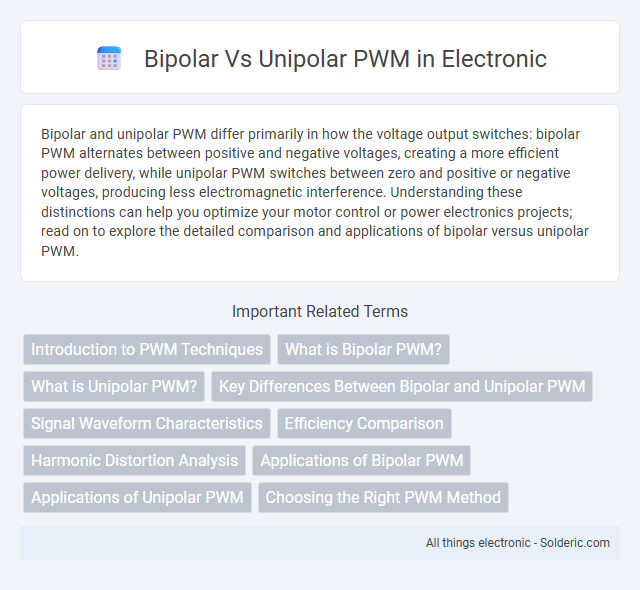Bipolar and unipolar PWM differ primarily in how the voltage output switches: bipolar PWM alternates between positive and negative voltages, creating a more efficient power delivery, while unipolar PWM switches between zero and positive or negative voltages, producing less electromagnetic interference. Understanding these distinctions can help you optimize your motor control or power electronics projects; read on to explore the detailed comparison and applications of bipolar versus unipolar PWM.
Comparison Table
| Feature | Bipolar PWM | Unipolar PWM |
|---|---|---|
| Switching Type | Output voltage switches between positive and negative rails | Output voltage switches between zero and positive or zero and negative rails |
| Output Voltage Waveform | Symmetrical waveform around zero voltage | Asymmetrical waveform centered around zero |
| Switching Loss | Higher due to full bridge switching | Lower as only half bridges switch at a time |
| Harmonic Content | Higher harmonics, more switching noise | Lower harmonics, reduced switching noise |
| Complexity | Simpler control strategy | More complex control and gate drive circuitry |
| Applications | AC motor drives, power inverters requiring full-bridge output | Efficient motor drives, reduced EMI applications |
Introduction to PWM Techniques
Pulse Width Modulation (PWM) techniques, including Bipolar and Unipolar PWM, are essential for controlling power in inverters and motor drives by varying the switching signals. Bipolar PWM switches voltage polarity between positive and negative pulses, resulting in higher harmonic distortion but simpler implementation. Unipolar PWM produces voltage pulses that switch between zero and positive or negative voltage, reducing voltage stress and harmonic content for improved efficiency and performance.
What is Bipolar PWM?
Bipolar PWM (Pulse Width Modulation) is a modulation technique where the output voltage alternates between positive and negative polarity around zero, creating a waveform that switches between +V and -V. This method reduces harmonic distortion and improves the efficiency of power conversion in inverters and motor drives by providing a smoother waveform compared to unipolar PWM. Understanding Bipolar PWM can enhance your ability to design circuits with better control and reduced electromagnetic interference.
What is Unipolar PWM?
Unipolar PWM (Pulse Width Modulation) is a technique used in inverters where the output voltage switches between zero and a positive or negative voltage, eliminating the negative voltage swing seen in bipolar PWM. This method reduces switching losses and electromagnetic interference by maintaining a single polarity at a time, commonly used in motor control and power electronics applications. Unipolar PWM improves efficiency and thermal performance in devices such as voltage source inverters and DC-AC converters.
Key Differences Between Bipolar and Unipolar PWM
Bipolar PWM signals switch the voltage between positive and negative levels, resulting in a full voltage swing across the load, enhancing torque and reducing harmonic distortion in motor control applications. Unipolar PWM switches between zero and a positive or negative voltage, producing a less complex signal with reduced switching losses and lower electromagnetic interference. The key differences lie in the switching pattern, voltage levels applied to the load, and the resulting impact on efficiency, noise, and harmonic content in power electronics systems.
Signal Waveform Characteristics
Bipolar PWM features a signal waveform that switches polarity between positive and negative voltages, creating a symmetrical square wave with zero average voltage over a switching cycle, which reduces harmonic distortion and electromagnetic interference. Unipolar PWM maintains a constant polarity and switches between zero and a positive voltage, resulting in an asymmetric waveform with higher harmonic content but simpler circuit implementation. The choice between bipolar and unipolar PWM impacts the efficiency and quality of power delivery in motor drives and inverter systems.
Efficiency Comparison
Bipolar PWM offers higher efficiency by switching the voltage polarity across the load, reducing power losses and improving thermal management in power electronics. Unipolar PWM, while simpler in design, typically has lower efficiency due to only switching voltage between zero and positive or negative, leading to higher switching losses. Your choice between bipolar and unipolar PWM directly impacts the overall system efficiency and thermal performance in applications like motor drives or inverters.
Harmonic Distortion Analysis
Bipolar PWM exhibits higher harmonic distortion in lower frequency ranges due to frequent switching transitions between positive and negative voltage levels, causing increased electromagnetic interference. Unipolar PWM reduces harmonic distortion by switching voltage between zero and either positive or negative states, resulting in lower switching losses and improved spectral performance. Harmonic distortion analysis reveals unipolar PWM provides cleaner output waveforms, crucial for minimizing audio noise and enhancing motor drive efficiency.
Applications of Bipolar PWM
Bipolar PWM is widely used in motor control applications due to its ability to efficiently reduce harmonic distortion and improve torque performance in AC drives and variable frequency drives (VFDs). It is also favored in power inverters for renewable energy systems, such as solar and wind, where precise voltage regulation and switching performance are critical. These applications benefit from Bipolar PWM's symmetrical switching waveform, which enhances power quality and extends the lifespan of electronic components.
Applications of Unipolar PWM
Unipolar PWM is widely used in applications requiring precise motor control and reduced electromagnetic interference, such as in brushless DC motors and servo drives. Your choice of unipolar PWM allows for smoother switching and lower harmonic distortion, making it ideal for power inverters and voltage regulator modules. This method enhances efficiency and reliability in renewable energy systems and industrial automation.
Choosing the Right PWM Method
Choosing the right PWM method depends on the specific application requirements, where bipolar PWM offers a simpler design with lower switching frequency harmonics but may introduce more electromagnetic interference (EMI). Unipolar PWM provides reduced harmonic distortion and improved efficiency by switching only one transistor at a time, making it ideal for high-performance motor drives and precise power control. Evaluating factors such as switching losses, noise levels, and application sensitivity ensures optimal selection between bipolar and unipolar PWM techniques.
Bipolar vs Unipolar PWM Infographic

 solderic.com
solderic.com